Quick search
CTRL+K
Quick search
CTRL+K

Madrid is an impressive city and the political center of Spain. The city in the middle of the Iberian Peninsula has been Spain’s unifying political entity for centuries, and the status as an imperial capital for centuries has put its distinct mark on the city with numerous grand buildings, sqaures, monuments and more, with the Royal Palace as one of the absolute highlights.
Tourists can enjoy the blend of magnificent historical greatness and the typical Spanish-Mediterranean atmospheric that is prevailing here. You should not miss out the narrow streets and fine squares of old Madrid near the famous Puerto del Sol and Plaza Mayor. And just next to the old neighborhood, you can stroll Gran Via with all it shopping and distinguished architecture.
Madrid is both a city of great buildings and monuments and a city where visitors come to enjoy the unforgettable art museums including the Prado Museum. The great European masters are innumerable in several museums, and close by there are beautiful parks to walk while digesting the impressions from the museums, or to meet the locals who spend a lot of time in the city’s green oases.
Madrid is also home to several major football teams including history’s most successful club, Real Madrid, and you can always check out if there are upscoming matches when visiting the city. You can also choose to make a day trip from the Spanish capital. The city of Toledo, El Escorial and Valle de los Caidos are great choices.
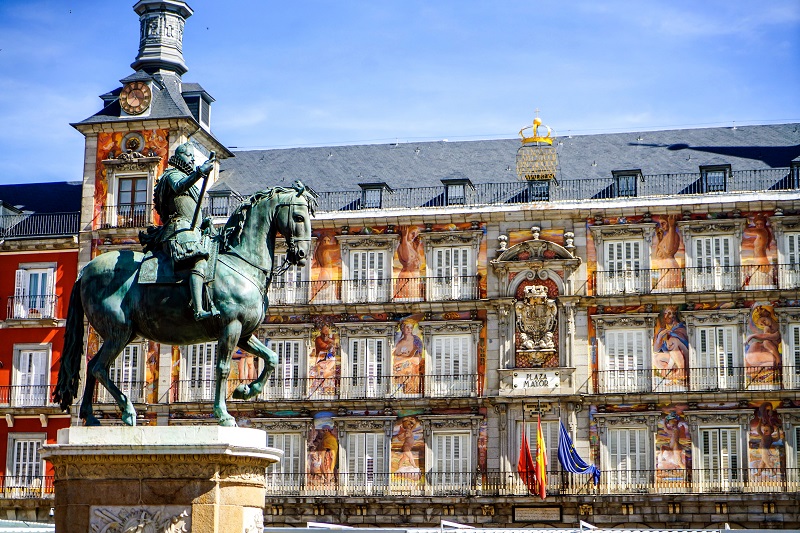
Plaza Mayor is one of the most beautiful squares in Europe from its time. The rectangular square measures 129×94 meters and was designed in 1581, when King Filipe II wanted to renovate the Plaza del Arrabel area, as the place was then called.
However, the construction did not start until 1617, when King Filipe III started the work. However, the square that you see today was laid out from 1790, when fires had ravaged the neighbourhood. The equestrian statue in the middle is from 1616; it depicts Philip III and was erected here in 1848.
Since its construction, Plaza Mayor has played a central role in Madrid’s history. Great festivals, coronations and bullfights have taken place here. To this day, various activities and performances continue to take place in the Plaza Mayor, and it is a special experience to witness the atmosphere. You can also just sit and relax here in the splendid urban space with the surrounding baroque buildings. It is a true oasis just a few meters from the hectic metropolis traffic.
The Puerto del Sol square is Madrid’s ever-pulsating center, which can be easily reached from all stations on the city’s metro network. Puerto del Sol means the Gate of the Sun, and here stood the eastern of the city’s gates in the 15th-century city walls. The sun rose to the east, and that’s how it got its name.
On the south side of Puerto del Sol is the most significant and central building in the square. It is a former post office, Real Casa de Correos, which was built in the years 1766-1768. The building was designed as the Ministry of the Interior during the era of Francisco Franco’s government, and today it houses part of Madrid’s administration.
The square Puerto del Sol is also the center of the whole of Spain, as the country’s kilometer distances are measured from here. In front of the Real Casa de Correos to the south, you can see the kilometer stone itself.
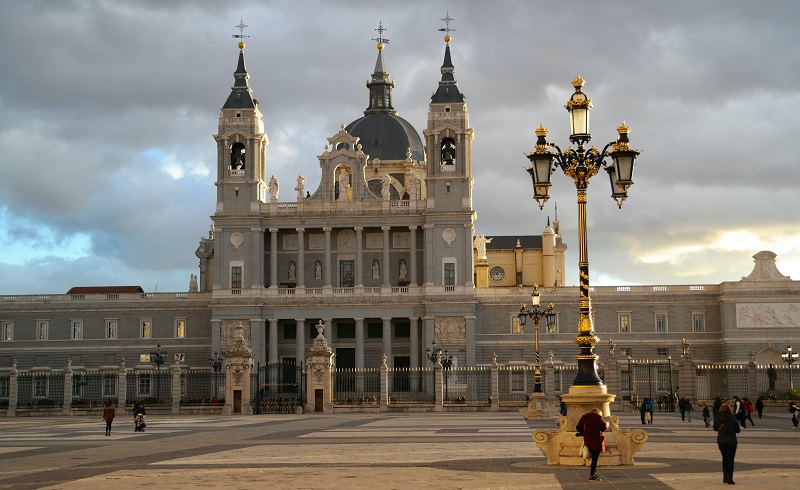
Almudena Cathedral is Madrid’s cathedral, and plans for it date back to the 16th century. In 1561, the capital of Spain was moved from Toledo to Madrid, and in the court’s new city there was no cathedral at the time. However, the plans for a new church in Madrid initially had to give way to the financial considerations of developing the Spanish colonies, and due to later postponements, construction did not begin until 1879.
The site for the construction was chosen to be directly opposite the Spanish royal palace. In this place there was probably a mosque before the Spanish reconquest of the Iberian Peninsula from the Muslim Moors; Alfonso VI wrested Madrid back to Spain in 1083.
In 1879, construction began, and the Madrid cathedral was a large building. The architect behind the plans was Francisco de Cubas, who designed the church in neo-Gothic style. Construction was not finished when the Spanish Civil War broke out in 1936, and with the war, construction stopped and the church fell into disrepair until 1950.
Fernando Chueca Goitia took over the responsibility for the completion of the Almudena Cathedral, and he changed the original Neo-Gothic plans to a Baroque architectural style to match the facades of the Royal Palace and thereby a stylistic harmony. The Catedral de la Almudena was then completed, and it was blessed by the Pope in 1993.
The interior is a very modern and colorful version of Neo-Gothic, and it is an interesting experience. In 2004, pictures from the cathedral were also seen all over the world, as the church laid the floor for the wedding between the Spanish Crown Prince Felipe and Letizia Ortiz. They were married in some impressive settings, the dimensions of the church being 102 meters in length, 68 meters in width and 73 meters in height.
Almudena Cathedral’s formal name is Santa Maria La Real de La Almudena, and it is the seat of the Bishop of Madrid. The country’s ecclesiastical center remained in Toledo in 1561, when Madrid became the Spanish capital. The church is dedicated to the Virgin of Almudena, who is the patron saint of Madrid.
Museo del Prado is the most important national Spanish art museum, and it is world-renowned for its fine, large collections, not least visual arts and sculptures. The museum is one of the world leaders in European art from the 12th century to around 1900, and it is here that you can experience, among other things, the largest collection of Spanish art from the period in the world.
The Prado Museum’s many works of art date back to the royal Spanish collections, and the museum itself was established as early as 1819 as a museum for paintings and sculptures. The museum building was built at the end of the 18th century and should have been used for natural history purposes, but King Ferdinand VII decided that the beautiful setting should be an art museum.
For visitors, the Museo del Prado is a cornucopia of works of art, and countless great masters are represented. You can thus see creations by, among others, Goya, Rembrandt, Rubens, Raphael, El Greco, Titian and Velázquez.
There are many special works one can visit the museum to see. Perhaps the most well-known is Diego Velázquez’s painting The Maids/Las Meninas, which is considered to be the artist’s main work and also a high point in European Baroque painting. It is believed that Velázquez used the picture to paint an everyday scene from the Alcázar castle in Madrid. You can also see Diego Valázquez himself; he is seen as the painter on the left side, while the viewer is seen centrally as a mirror image.
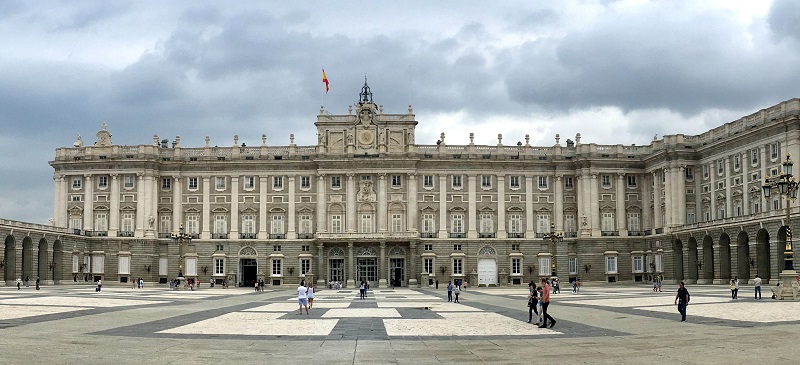
This is the royal palace of Spain and it is in continued use by the Spanish monarch. With its more than 2,000 rooms, the Palacio Real is also one of Europe’s largest royal palaces, and it is a fantastic spectacle that awaits visitors in the palace’s rooms and halls.
The Palacio Real building complex was built several times, and before the current castle there was a fortification on the site as early as the time of the Moors in the city. After the Moors, the Spaniards maintained the site as a fortification for the city.
After the fortress castle itself, a large residence castle arose over time. The oldest parts of the castle were around the Kongens Gård/Patio del Rey, and they date from the Middle Ages. Later, the Royal Chapel/Capilla Real, the galleries Galería del Cierzo and Galería del Rey, the towers Torre de Carlos I, Torre Dorada and Torre de la Reina as well as the wings around the Queen’s Court/Patio de la Reina were built.
The large facility caught fire on Christmas Eve in 1734, and the fire raged for four days before it was extinguished. The fire destroyed the old building, and the remaining walls were demolished in 1738.
The architect Filippo Juvarra designed a grand new royal palace, but he died before work began. Therefore, Giovanni Battista, who was Juvarra’s student, continued with the master’s drawings and was in charge of the new castle, which was already extended in 1760 according to the neoclassical lines of the architect Francesco Sabatini. In the 19th century, the castle received parts of its current interior; this was mainly inspired by the Victorian style in England.
The castle was a royal residence until 1931, but is still used today for major royal ceremonies. You should treat yourself to a visit to the Palacio Real, which is one of Madrid’s most unforgettable places in terms of interior design; The Palacio Real’s location and associated park, its beautiful interior and the fine art collection with paintings by, among others, Goya, Rubens and Velázquez provide a fantastic overall experience.
The main facade of the Palacio Real facing the Plaza de la Armeria is dominated by the row of Ionic columns and four central Doric columns, which together give an austere classicist appearance. The balustrade at the top was formerly crowned with a series of statues of kings and saints, but King Carlos III had these removed to give the castle a more stylish exterior. Plaza de Armeria got its appearance in the 1890s, but it has been laid out since 1553.
Behind the castle’s magnificent architectural exterior, an incredible wealth of detail and diversity unfolds in the many halls you can visit. The tour starts impressively with Francesco Sabatini’s grand 18th-century staircase, the ceiling of which is adorned with distinguished frescoes by Corrado Giaquinto. The stairs lead up to the castle’s forecourt and to the throne room, which in its red, warm colors is a small wonder in itself.
The many following rooms are so different in decorations and interiors that one can spend hours exploring the palace’s many details. Notice the objects on display, which include Danish Flora Danica porcelain and several violins built by Stradivarius.
The Royal Chapel/Real Capilla was designed in 1748 by the architects Sacchetti and Ventura Rodríquez. The chapel is beautifully decorated with, among other things, ceiling paintings by Corrado Giaquinto and an altarpiece by Ramón Bayeu.
Don’t forget to also visit the old royal pharmacy from the castle grounds. The pharmacy gives a good impression of healing methods from recent centuries and gives a different perspective on the castle than the royal rooms and halls.
Thyssen-Bornemisza Museum is a large and famous museum that opened in 1992 with the background of Baron von Thyssen-Bornemisza’s large collection of paintings. The works date from the period from the 13th century to the 20th century, and it is therefore quite a broad museum collection that you can experience here.
The collection spans a significant amount of works by Italian, Flemish and Dutch artists from the 14th-15th centuries. There are also European paintings from the Renaissance, Baroque and Rococo periods. You can also experience American 18th-19th century artists and a lot of art from Impressionism and Post-Impressionism.
The long line of famous artists represented at the Museo Thyssen-Bornemisza includes Alfred Sisley, Claude Monet, van Gogh, Miró, Picasso, Raphael, Titian, Tintoretto, Albrecht Dürer and Van Dyck, among others.
The Reina Sofia art center complements Madrid’s two other large art museums on the Paseo del Prado with modern art from the 20th century. It is Spain’s national art museum for this period, and you can not least experience works by Spanish artists in the museum’s fine exhibition.
Here is a permanent exhibition with distinguished works of art by Salvador Dalí, Pablo Picasso and more. Picasso is the man behind the museum’s most famous work, Guernica. Guernica measures 776×349 cm and was painted in 1937. The large oil painting depicts Picasso’s depiction of the bombing of the Basque town of Guernica in the same year.
You can experience many Spanish 20th century artists, and here are also works by international celebrities such as Paul Klee, Henry Moore, Diego Rivera, Damien Hirst and René Magritte.
In addition to the Reina Sofia Museum’s own permanent collection, changing exhibitions are regularly organized at a level that makes the place one of the world’s great museums for modern and contemporary art.
The museum’s central building is housed in a former hospital, the construction of which was started by King Ferdinand VI in the mid-1700s. The hospital was opened in 1805 and operated as such until 1969.
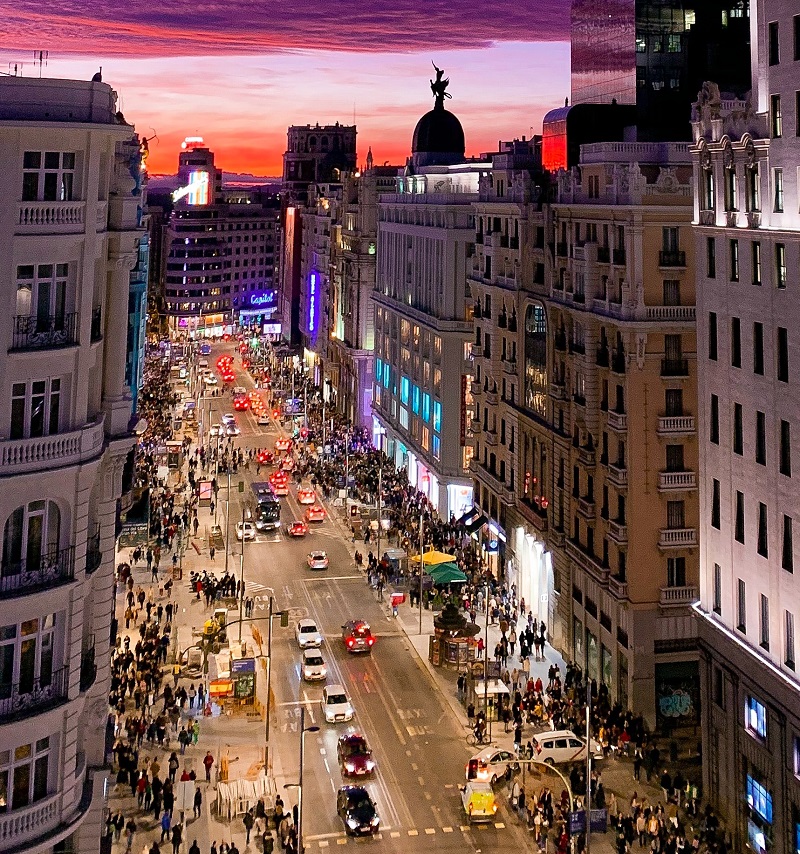
Gran Via is Madrid’s fashionable business district, and it was laid out as a large-scale project in the 1920s between Plaza de Cibeles and Plaza de España. Many of Spain’s leading companies sought to surpass each other in the expensive construction of the time, and therefore the street stands today as a long string of impressive buildings. Finally, remember to notice the many details and variations between the individual constructions, of which only the most well-known are mentioned here.
From the east end, you are met by the Metropolis building, Edificio Metrópolis, built 1907-1911. On top of the richly ornamented dome you can see the winged goddess of victory. Further to the west stands the building Edificio Grassy from 1917, and again a little further on is the 88 meter high Telefónica building, which after its construction in 1926-1929 was the city’s tallest.
Where the Gran Via breaks to the northwest, at the Plaza del Callao, is a row of traditional cinemas, of which the Capitol is one of Madrid’s beautiful Art Deco houses.
Mercado de San Miguel is a cozy market that is interesting for its interior in an atmospheric wrought iron building, which was built 1913-1916. The market building underwent a major renovation before the site reopened in a modern setting in 2009.
Today, the Mercado de San Miguel is a popular place where Madrilenians and visitors to the city can enjoy gourmet tapas and other delicacies from Spanish cuisine such as tasty ham and wine.
This large, twin-towered church is one of Madrid’s well-known churches. Built as a Jesuit church, it served as a temporary cathedral while the Catedral de la Almudena was being built.
It was the architect Pedro Sánchez who designed the church, which was built with partial inspiration from the Gesu Church in Rome. Construction began in 1622, and the beautiful building was completed in 1664. However, it had already been consecrated as a church in 1651. Before the current one, there was also a church on the site, which had been consecrated in 1567.
The Basilica de San Isidro is named after Madrid’s patron Saint Isidro. Saint Isidro lived in the period 1070-1130 and was known for his mercy to animals and the poor. The remains of Saint Isidro have been stored in the church since 1769, when the church also ceased to be a Jesuit church in connection with the expulsion of this order from Madrid.
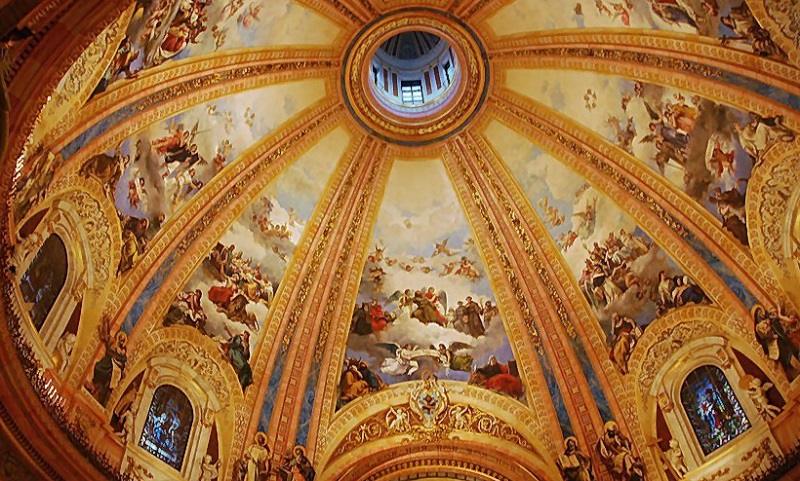
Royal Basilica of San Francisco el Grande was one of Madrid’s most important church buildings before the opening of the Catedral de la Almudena. It was built as a monastery church for the Franciscan monastery that was founded on the site already in the 13th century.
The current church is somewhat newer than the monastery, as it was built in the latter half of the 18th century. The starting point was drawn by the architect Francisco Cabezas, and both Antonio Pló and Francesco Sabatini worked on the design, the result of which was a richly decorated neoclassical architecture.
From the outside, the very large dome is impressive, and inside you can admire a number of works of art, such as Goya’s painting of Bernadinus of Siena.
The Plaza de Oriente is a grand and elegant square that was laid out on the Parisian model during the reign of Joseph Bonaparte. Previously, there were a number of housing blocks on the site. They were renovated, and the idea was that a boulevard like the Champs-Élysées should also be built. However, that part of Bonaparte’s plan did not come to fruition.
There are many things to see in the square. This applies not least to the 44 statues that are lined up in two rows. They depict kings and queens who have been regents on the Iberian Peninsula. In the center you can see an equestrian statue of King Felipe IV. The Royal Theater/Teatro Real and the Royal Palace/Palacio Real are located on opposite sides of the square.
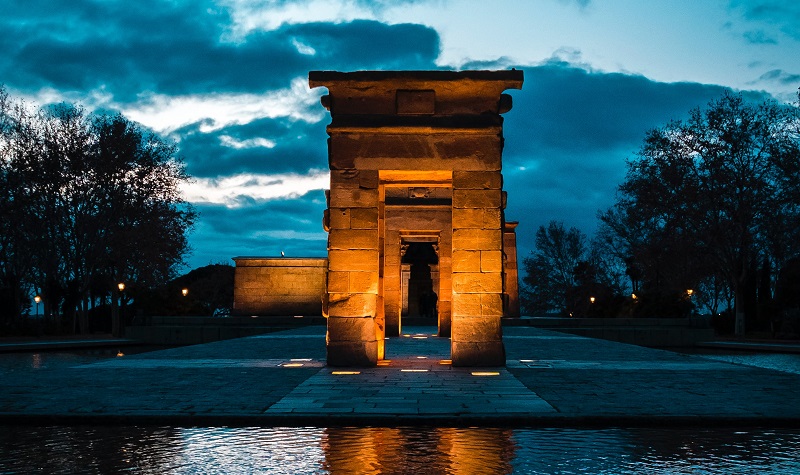
Templo de Debod is something as special as an original Egyptian temple in the middle of Madrid. It was erected in Philea in southern Egypt in the 100s BC. under King Tabriqo, and it was later expanded by various kings and under the Roman emperors Augustus and Tiberius.
When the Aswan Dam was going to be built in Egypt, the country asked for help to protect the unique treasures that would be flooded. In gratitude for Spanish help in moving the Abu Simbel temples, the Egyptian state gave the Templo de Debod to Spain in 1968. It was rebuilt in beautiful surroundings in Madrid and opened in 1971.
This is Spain’s national archaeological museum, which exhibits a wide range of effects found throughout the country as well as some foreign effects. One of the highlights is the Islamic collection, which with the long period of the Moors in Spain is naturally voluminous.
The museum was founded in 1867 by decree of Queen Isabella II. In 1895 it moved to the current building, built 1868-1892, which is shared between the museum and the Spanish National Library.
When exploring the building’s exhibition, you can experience, among other things, the Pozo Moro Mausoleum/Sepulcro de Pozo Moro, which was erected as a tombstone in the 5th century BC. There are also beautifully preserved statues from the 3rd century BC, the exciting Guarrazar treasure and much more.
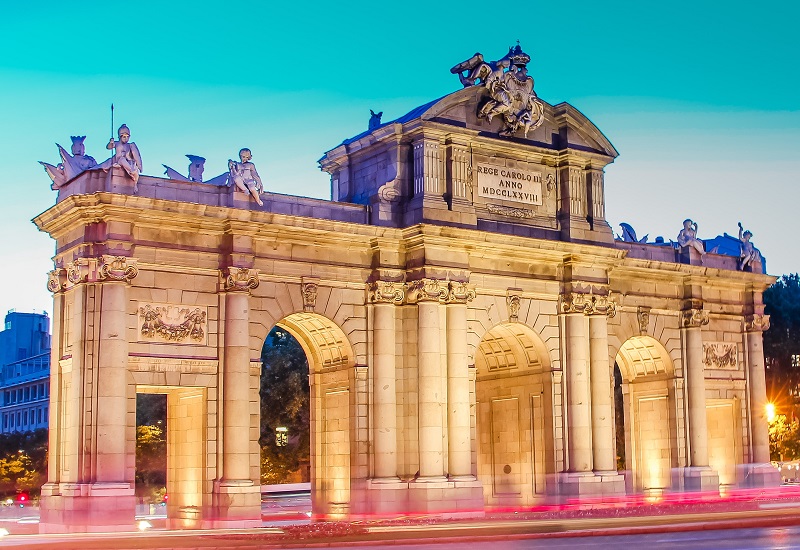
In Madrid’s Independence Square is the Alcalá Gate, Puerto de Alcalá, which was built in 1778 as the first European triumphal arch since the construction of arches in its time by the Roman Empire.
The gate was inaugurated as an integral part of Madrid’s city walls at the site where the road to the city of Alcalá lay. It was King Carlos III’s idea to make the city more beautiful to the east, and therefore an earlier gate was replaced by the new, beautiful gate.
The 1.4 km² Retiro Park is located in the center of Madrid and is a very popular place for Madrilenians to take a stroll or to enjoy time with the family.
The park was laid out as a castle park for Madrid’s Alcázar Castle in 1632, and at that time it was outside the city. You can still see the lines of the old park, although it has changed since then. The castle itself was destroyed during the Napoleonic Wars and can no longer be visited.
Gardens, fountains and flowers surround visitors who can also stop by the Palacio de Velázquez and Palacio de Cristal buildings, both built in the late 19th century. The fine glass building Krystelpaladaset/Palacio de Cristal was also built with inspiration from the Crystal Palace in London.
In the center of the park you can see an impressive monument to King Alfonso XII 1901. It consists of a semicircular colonnade surrounding the king, who is depicted in the form of a tall equestrian statue. The monument stands on the shore of a large artificial lake where you can rent boats. Around the lake there are several nice restaurants, so there are every opportunity to enjoy some time in the park.
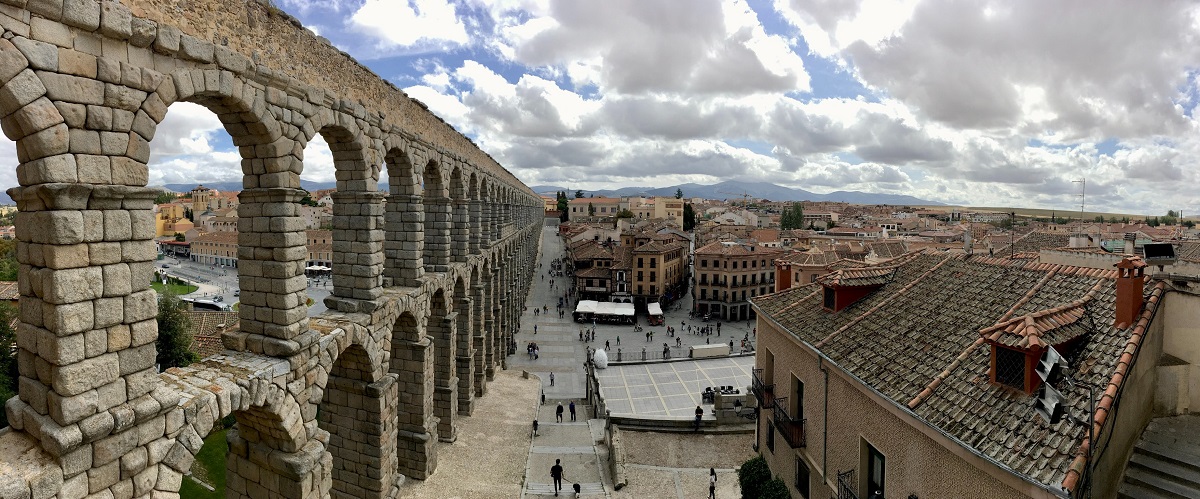
In the city of Segovia you can experience many facets of Spain’s history. You get an impression from the country’s Roman and Spanish times, through the Middle Ages and the Renaissance to today, and the old town with all the interesting places is also on UNESCO’s list of world cultural heritage.
Perhaps the city’s best-known monument is the Roman aqueduct, Acueducto de Segovia (between Plaza del Azoguejo and Plaza Díaz Sanz), from around the year 100. It cuts into the city center from the eastern side and was once built to transport water from the mountains 17 km. away and into Segovia. In the center of the city, the building reaches an impressive height of 28 metres.
The city’s large Gothic cathedral, Catedral de Segovia (Plaza Mayor), was built in the period 1522-1577, and it towers over the old town and can thereby be seen knowledge of. The cathedral is considered the last of Europe’s great Gothic cathedrals.
Segovia’s fortress, Alcázar de Segovia (Plazuela de Juan Guás), was founded in the 11th century and is breathtakingly situated on a rocky outcrop at the extreme west of the city. Over time, the fortress has been continuously expanded, not least because the kings of Castile often lived here and wanted to leave their mark on it.
El Escorial is one of the world’s largest castle complexes with an impressive 30,000 m² in a ground plan measuring 244×153 meters. The entire main complex of El Escorial contains a castle, a monastery, a library and various functions linked to this. In addition to this part, there is a hunting lodge a few kilometers away. It is called La Granjilla de La Fresneda.
It was King Felipe II who ordered El Escorial built after the victory over France in 1557. Construction started in 1563 on a plateau near a small village, which later developed into today’s larger settlement of El Escorial. The complex was built strictly symmetrically and with a grandeur that should emphasize the rule and power of the Spanish kings. El Escorial was completed in 1584.
Finally, remember to set aside plenty of time for the visit and see all the exciting parts of the building that are there to experience. Some of the castle’s highlights are the royal suites with the king’s and queen’s rooms; they give a good impression of what the royal family’s private life was like. An entrance is via the Main Staircase/Escalera Principal, whose ceiling frescoes are very impressive.
There are several large halls, which are thematically decorated, and one of the most elegantly decorated is the 60×6 meter hall Sala de las Batallas, which depicts various Spanish battles and victories.
Kings and queens are buried in El Escorial’s crypt, and it is one of the castle’s most beautiful and unforgettable rooms. Virtually the entire Spanish royal line is located here, and most queens’ tombs are also in the crypt.
The monastery of El Escorial continues to function as a monastery, and there is therefore limited access for visitors to this part of the large complex. However, the beautiful El Escorial Basilica/Basílica de El Escorial in the center of the monastery is open and it is an experience. Of the church’s interior, the 28 meter high altar section is particularly interesting with its many colors and fine decoration.
It is also worth visiting the library with its impressive collections and it gives a good impression of the scale of the work at a place like El Escorial. The library is arranged in a 54 meter long hall that has 10 meters up to the curved ceiling. Marble on the floor and paintings all over the ceiling make it one of the complex’s absolute most spectacular rooms.
El Escorial’s collection of European art is rich, and some of the works can be seen in the on-site art gallery. Among other things, you can see works by Titian, Hieronymus Bosch, van der Weyden, El Greco and Diego Velázquez.
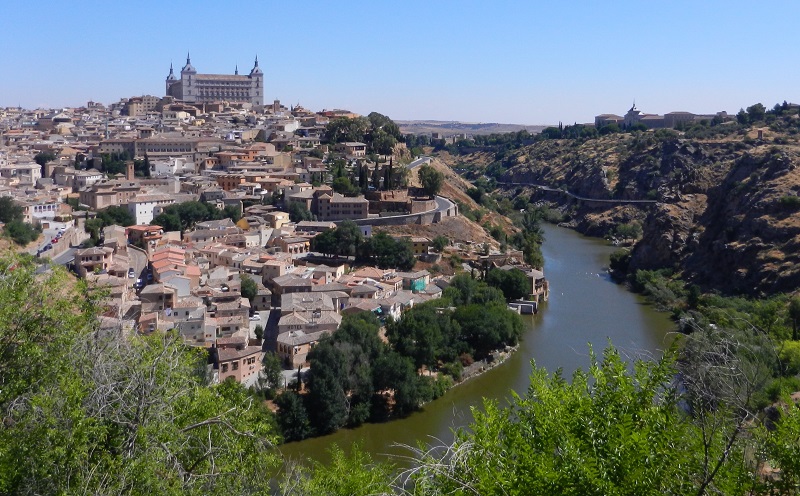
Toledo is a city with a location on a small mountaintop on the Castilian plateau that is unique and highly picturesque. The Tagus River literally winds around the rock where the old town is located. From this view, you can easily understand that the city is on UNESCO’s list of world cultural heritage.
Toledo was the capital of the region from 561 to 711, and again from the Middle Ages until 1561, when King Felipe II moved the court to Madrid. However, Toledo remains the religious center of the country, which is underlined by the impressive cathedral, which is a must-see when visiting the city. One of the historical characteristics of the city was also that Christian, Jewish and Moorish culture lived and flourished side by side over time.
The Valle de los Caidos is a large memorial that was created in memory of those who fell on both sides of the Spanish Civil War. Up to 40,000 soldiers are buried in the valley itself. The history of the place started in 1940, when it was decided to build a monument consisting of a high granite cross and a monumental church at the 1,300 meter height of the Guadarrama mountains. Both buildings were both completed in 1959.
The memorial’s cross weighs more than 200,000 tons, it is 152 meters high and the arms are 46 meters wide. Those dimensions say something about the grandeur of the monument, which every visitor cannot fail to be impressed by. The size was a symbol of Francisco Franco’s capacity as a great leader. The architecture is inspired by, among others, Albert Speer’s and Benito Mussolini’s magnificent buildings in Germany and Italy, and it is a distinguished example of the large public Spanish buildings of the post-war period.
The church was blasted 250 meters into the rock and looks like a long tunnel. At the altar at the end, Francisco Franco and José Antonio, who was the founder of the Falangist party, were buried. The church room was built as the world’s longest, but the Pope has only dedicated a room, which is slightly shorter than St. Peter’s Basilica in Rome, as an official church room. On that occasion, the Pope made the site a basilica with the name Santa Cruz.
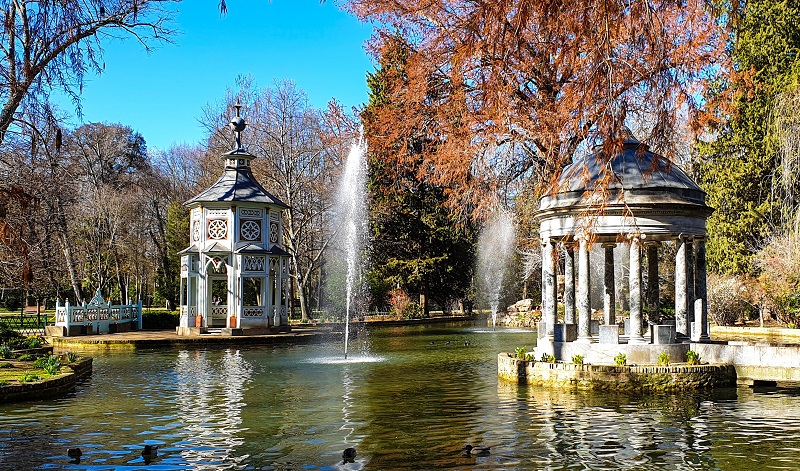
Aranjuez Palace is one of Spain’s most elegant palaces. King Felipe II began construction in 1560, but it was King Felipe V who created the current appearance in the 18th century.
Inside the castle, the Porcelain Hall/Gabinete de Porcelana and the Mirror Hall/Gabinete de Espejos are particularly noteworthy. The castle garden/Jardín de la Isla is graceful and at the same time grandly laid out and also worth a trip. Here you can see, among other things, a number of Italian fountains from the 16th and 17th centuries. There are also museums in the area that show life at the castle, royal vehicles and so on.
The road to Aranjuez can be taken during the summer with the Strawberry Train/Tren de la Fresa, which departs from the Atocha railway station in Madrid. The train is beautiful and old and is supposed to give an illusion of the journey from the time of the railway in the 1800s.
Calle Serrano 61
abcserrano.com
Calle de Arturo Soria 126
arturosoriaplaza.es
Calle Preciados 1-3, Calle de Goya 76 and 85 and Calle Serrano 47 and 52
elcorteingles.es
Calle de Goya 6-8
jardindeserrano.es
Monforte de Lemos 36
enlavaguada.com
Polígono Európolis
mainoutlet.com
Avenida del General Perón 40
modashopping.com
At Autovía A-1
plazanorte2.com
At Autovía A-6
sextavenida.com
At Autovía A-5
millsmadridxanadu.com
Gran Via, Plaza del Callao, Puerto del Sol, Calle Preciados, Calle Fuencarral, Calle Serrano, Calle de Goya
Aquasur
Carretera Andalucía
Aranjuez, 45 km S
Aquopolis, Avenida de la Dahesa
Villaneuva de la Cañada, 35 km W
aquopolis.es
Museo del Aire
Carretera Extremadure
museodelaire.com
Museo del Ferrocarril
Paseo de las Delicias 61
museodelferrocarril.org
Museo Nacional de Ciencias Naturales
Calle José Gutiérrez Abascal 2
mncn.csic.es
Parque de Atracciones
Casa de Campo
parquedeatracciones.es
Safari Park
Carretera de Extremadura
Aldeo del Fresno
Warner Bros. Movie World
San Martin de la Vega, 25 km S
warnerbrospark.com
Zoo Aquarium Madrid
Casa de Campo
zoomadrid.com
The foundation of what was to become Madrid is not known for certain, but it is believed that the Romans established a settlement here in the 100th century BC. The settlement is believed to be called Magerit, which formed the starting point for today’s name Madrid.
After the fall of the Roman Empire, more people came to the area in the middle of the Iberian Peninsula. This applied to both vandals and Visigoths who ruled before the Islamic conquest of the region. It took place in the middle of the 8th century, when the Moors came to rule from Cordoba. They brought fortifications in what they called Mayrit; including a smaller castle in the place where the Spanish royal palace stands today.
The emirate’s emirate remained in the area until the 9th century, when the Castile from the north conquered more and more areas in the Christian re-occupation of the Iberian Peninsula. During Alfonso VI, the Arab Moors were forced to the south, and in 1085 the Castile conquered Madrid. However, the town remained a less significant village at this time, and it remained such a time.
Madrid grew steadily after the reconquest of the 11th century, and it was provided with funds through the Armenian King Levon V, who was granted a Madrid nobility title by Castile’s King Juan I in 1383.
Levon had come to court in the Medina del Campo and was granted the city of Madrid as his life-time property as well as the means to invest. Levon only ruled for a short time, but got construction started that increased Madrid’s importance. Among other things, he expanded the city’s castle.
After a few years, Madrid was hit by a major fire and King Henry III initiated a reconstruction. Madrid thereby maintained its new position as one of Castile’s important cities.
At that time there were two great kingdoms in the Iberian Peninsula; Castile and Aragon. In 1469, they were merged into a kingdom through the marriage of Isabella I of Castile and Ferdinand II of Aragon. Of the pope, they even obtained the title The Catholic Monarchs.
For a time, the following monarchs preferred different cities, but Madrid’s status as a defacto capital was introduced in 1561 by King Felipe II, when he moved to court. That position was the start of the city’s population and general activity increasing dramatically.
With Filipe II’s establishment in Madrid in 1561, the development of the city really took off. Large monuments were erected and the town plan was developed with, for example, the Plaza Mayor square. Thus, the time of the Habsburg royal house has given the city many of the sights to see in today’s Madrid.
With the king and Madrid at the center, Spain was developed, and in the capital, the arts flourished as well. It was a period of economic prosperity that came from, among others, Spain’s great colonial empire in America.
The 17th century was the Spanish Golden Age, the so-called golden century / siglo de oro. Here the art unfolded literary and in the visual arts, and great artists moved to Madrid; eg Cervantes and Velázquez.
The last Habsburg king was Carlos II, who died in the year 1700. His death started the Spanish War of Succession, which ended with France deploying the Bourbons as rulers.
The bourbons clearly initiated French-inspired construction projects, and in the first half of the 18th century larger installations such as the palace palace Real were started. The castle construction started in 1739 under Felipe V, and it was completed during Carlos III’s reign.
New areas were built in Madrid, and the area around the Prado Museum was largely built by Carlos III in the exact 18th century. One example is Puerto del Alcala, which was part of the new city, and in time French architects and consultants frequently participated in the construction work.
Around 1800, there were great thrills in Europe, which in the following years were characterized by the expansionary politics of French Napoleon. This was also the case for Spain, which was involved in the matches of the period.
Spain entered into an agreement with Napoleon in 1807. With the agreement, French troops gained access through Spain to Portugal, which did not want to participate in an international blockade against England.
France used the agreement to enter Spain, which was occupied along the way as troops arrived. Madrid was conquered in 1808, and Napoleon forced the Spanish kings to abdicate in favor of Josef Bonaparte, Napoleon’s brother and Spain’s new king.
As a regent, Josef Bonaparte made his mark on Madrid’s cityscape in the form of the distinguished and French-inspired installation of Plaza Oriente. The model was the elegance of the French capital Paris.
France was forced to retire after a few years, and in 1813 Spanish Fernando VII could be deployed as a new king. In 1820, the king accepted Spain’s first constitution, which made up the monarchy.
Isabella II became regent after Fernando VII in 1833, and the following decades were characterized by changing political directions and several political coups. The political consciousness of Madrid and the rising economic prosperity increased the distance to the monarchy, and in 1873 it culminated with the proclamation of Spain into republic.
However, the regime lasted briefly, and as early as 1875 the monarchy was reinstated. Madrid underwent significant economic progress for several decades, initially without major discrepancies between the ruler and the politicians.
Politically and economically, it went downhill in the reign of Alfonso XIII. The king chose a political solution with the imposition of a dictatorship under Primo de Rivera in 1923. However, the economy continued to decline strongly for the city and the country, and development culminated in 1931, when Spain was again declared republic.
Spain and not least Madrid with its large population was characterized by the same political influences that affected large parts of Europe in the 1930s.
The views of the working class emerged in Madrid in the same year that General Francisco Franco’s nationalist troops occupied an ever larger part of Spain and approached the city during the Spanish Civil War, which erupted in 1936. Madrid was fought until the end of the Spanish Civil War in 1939.
Francisco Franco was deployed as dictator in Spain, and he was to rule the country for more than 35 years. The first years after the end of the Spanish Civil War were financially very tough for Madrid and for Spain. There was war in Europe, while Spain had to be rebuilt in many ways.
For Madrid, construction of large residential areas was initiated during Franco’s time, and large new production facilities were established south of Madrid, together with housing and general expansion.
After Franco’s death in 1975, Juan Carlos was deployed as king, and Madrid again became a royal city. At the same time, democracy was introduced in Spain. The first elections were held in 1977.
Throughout the 1980s, Madrid flourished culturally, and both the city and the country underwent great economic development; through membership of the EC and later the EU. Things were going strong in Madrid, and in 1992 the city was chosen as a European cultural city. This and many other cultural initiatives have been instrumental in forming the charming and beautiful metropolis that visitors experience today.
 Madrid, Spain[/caption]
Madrid, Spain[/caption]
Overview of Madrid
Madrid is an impressive city and the political center of Spain. The city in the middle of the Iberian Peninsula has been Spain’s unifying political entity for centuries, and the status as an imperial capital for centuries has put its distinct mark on the city with numerous grand buildings, sqaures, monuments and more, with the Royal Palace as one of the absolute highlights.
Tourists can enjoy the blend of magnificent historical greatness and the typical Spanish-Mediterranean atmospheric that is prevailing here. You should not miss out the narrow streets and fine squares of old Madrid near the famous Puerto del Sol and Plaza Mayor. And just next to the old neighborhood, you can stroll Gran Via with all it shopping and distinguished architecture.
Madrid is both a city of great buildings and monuments and a city where visitors come to enjoy the unforgettable art museums including the Prado Museum. The great European masters are innumerable in several museums, and close by there are beautiful parks to walk while digesting the impressions from the museums, or to meet the locals who spend a lot of time in the city’s green oases.
About the Whitehorse travel guide
Contents: Tours in the city + tours in the surrounding area
Published: Released soon
Author: Stig Albeck
Publisher: Vamados.com
Language: English
About the travel guide
The Whitehorse travel guide gives you an overview of the sights and activities of the Canadian city. Read about top sights and other sights, and get a tour guide with tour suggestions and detailed descriptions of all the city’s most important churches, monuments, mansions, museums, etc.
Whitehorse is waiting for you, and at vamados.com you can also find cheap flights and great deals on hotels for your trip. You just select your travel dates and then you get flight and accommodation suggestions in and around the city.
Read more about Whitehorse and Canada
Canada Travel Guide: https://vamados.com/canada
City tourism: https://visitwhite-horse.ca
Main Page: https://www.vamados.com/
Buy the travel guide
Click the “Add to Cart” button to purchase the travel guide. After that you will come to the payment, where you enter the purchase and payment information. Upon payment of the travel guide, you will immediately receive a receipt with a link to download your purchase. You can download the travel guide immediately or use the download link in the email later.
Use the travel guide
When you buy the travel guide to Whitehorse you get the book online so you can have it on your phone, tablet or computer – and of course you can choose to print it. Use the maps and tour suggestions and you will have a good and content-rich journey.


Gran Via is Madrid’s fashionable business district, and it was laid out as a large-scale project in the 1920s between Plaza de Cibeles and Plaza de España. Many of Spain’s leading companies sought to surpass each other in the expensive construction of the time, and therefore the street stands today as a long string of impressive buildings. Finally, remember to notice the many details and variations between the individual constructions, of which only the most well-known are mentioned here.
From the east end, you are met by the Metropolis building, Edificio Metrópolis, built 1907-1911. On top of the richly ornamented dome you can see the winged goddess of victory. Further to the west stands the building Edificio Grassy from 1917, and again a little further on is the 88 meter high Telefónica building, which after its construction in 1926-1929 was the city’s tallest.
Where the Gran Via breaks to the northwest, at the Plaza del Callao, is a row of traditional cinemas, of which the Capitol is one of Madrid’s beautiful Art Deco houses.
Mercado de San Miguel is a cozy market that is interesting for its interior in an atmospheric wrought iron building, which was built 1913-1916. The market building underwent a major renovation before the site reopened in a modern setting in 2009.
Today, the Mercado de San Miguel is a popular place where Madrilenians and visitors to the city can enjoy gourmet tapas and other delicacies from Spanish cuisine such as tasty ham and wine.
This large, twin-towered church is one of Madrid’s well-known churches. Built as a Jesuit church, it served as a temporary cathedral while the Catedral de la Almudena was being built.
It was the architect Pedro Sánchez who designed the church, which was built with partial inspiration from the Gesu Church in Rome. Construction began in 1622, and the beautiful building was completed in 1664. However, it had already been consecrated as a church in 1651. Before the current one, there was also a church on the site, which had been consecrated in 1567.
The Basilica de San Isidro is named after Madrid’s patron Saint Isidro. Saint Isidro lived in the period 1070-1130 and was known for his mercy to animals and the poor. The remains of Saint Isidro have been stored in the church since 1769, when the church also ceased to be a Jesuit church in connection with the expulsion of this order from Madrid.

Royal Basilica of San Francisco el Grande was one of Madrid’s most important church buildings before the opening of the Catedral de la Almudena. It was built as a monastery church for the Franciscan monastery that was founded on the site already in the 13th century.
The current church is somewhat newer than the monastery, as it was built in the latter half of the 18th century. The starting point was drawn by the architect Francisco Cabezas, and both Antonio Pló and Francesco Sabatini worked on the design, the result of which was a richly decorated neoclassical architecture.
From the outside, the very large dome is impressive, and inside you can admire a number of works of art, such as Goya’s painting of Bernadinus of Siena.
The Plaza de Oriente is a grand and elegant square that was laid out on the Parisian model during the reign of Joseph Bonaparte. Previously, there were a number of housing blocks on the site. They were renovated, and the idea was that a boulevard like the Champs-Élysées should also be built. However, that part of Bonaparte’s plan did not come to fruition.
There are many things to see in the square. This applies not least to the 44 statues that are lined up in two rows. They depict kings and queens who have been regents on the Iberian Peninsula. In the center you can see an equestrian statue of King Felipe IV. The Royal Theater/Teatro Real and the Royal Palace/Palacio Real are located on opposite sides of the square.

Templo de Debod is something as special as an original Egyptian temple in the middle of Madrid. It was erected in Philea in southern Egypt in the 100s BC. under King Tabriqo, and it was later expanded by various kings and under the Roman emperors Augustus and Tiberius.
When the Aswan Dam was going to be built in Egypt, the country asked for help to protect the unique treasures that would be flooded. In gratitude for Spanish help in moving the Abu Simbel temples, the Egyptian state gave the Templo de Debod to Spain in 1968. It was rebuilt in beautiful surroundings in Madrid and opened in 1971.
This is Spain’s national archaeological museum, which exhibits a wide range of effects found throughout the country as well as some foreign effects. One of the highlights is the Islamic collection, which with the long period of the Moors in Spain is naturally voluminous.
The museum was founded in 1867 by decree of Queen Isabella II. In 1895 it moved to the current building, built 1868-1892, which is shared between the museum and the Spanish National Library.
When exploring the building’s exhibition, you can experience, among other things, the Pozo Moro Mausoleum/Sepulcro de Pozo Moro, which was erected as a tombstone in the 5th century BC. There are also beautifully preserved statues from the 3rd century BC, the exciting Guarrazar treasure and much more.

In Madrid’s Independence Square is the Alcalá Gate, Puerto de Alcalá, which was built in 1778 as the first European triumphal arch since the construction of arches in its time by the Roman Empire.
The gate was inaugurated as an integral part of Madrid’s city walls at the site where the road to the city of Alcalá lay. It was King Carlos III’s idea to make the city more beautiful to the east, and therefore an earlier gate was replaced by the new, beautiful gate.
The 1.4 km² Retiro Park is located in the center of Madrid and is a very popular place for Madrilenians to take a stroll or to enjoy time with the family.
The park was laid out as a castle park for Madrid’s Alcázar Castle in 1632, and at that time it was outside the city. You can still see the lines of the old park, although it has changed since then. The castle itself was destroyed during the Napoleonic Wars and can no longer be visited.
Gardens, fountains and flowers surround visitors who can also stop by the Palacio de Velázquez and Palacio de Cristal buildings, both built in the late 19th century. The fine glass building Krystelpaladaset/Palacio de Cristal was also built with inspiration from the Crystal Palace in London.
In the center of the park you can see an impressive monument to King Alfonso XII 1901. It consists of a semicircular colonnade surrounding the king, who is depicted in the form of a tall equestrian statue. The monument stands on the shore of a large artificial lake where you can rent boats. Around the lake there are several nice restaurants, so there are every opportunity to enjoy some time in the park.
Similar to Madrid Travel Guide
